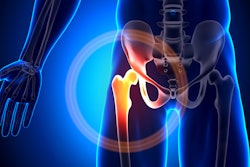The case for screening older adults with bone density scans has gotten a big boost. A newly published study has confirmed, for the first time, that screening with dual-energy x-ray absorptiometry (DEXA) at the hip is associated with reducing hip fractures.
Looking at nearly 5,000 patients followed for an average of 4.9 years, the researchers found there were 36% fewer hip fractures among patients who had undergone DEXA screening.
The group couldn't fully explain why the reduction had occurred, as only a small additional percentage of those patients who had undergone screening had subsequently increased their calcium, bisphosphonate, or multivitamin intake.
The study, led by first author and public health specialist Dr. Lisa M. Kern of Weill Medical College in New York City, was published this month in the Annals of Internal Medicine (February 1, 2005, Vol. 142:3, pp. 173-181).
Other participating institutions included the Johns Hopkins School of Medicine in Baltimore; Cleveland Clinic Foundation in Ohio; University of Washington in Seattle; University of California, Davis; and the National Institute on Aging in Bethesda, Maryland.
The study evaluated data from a random, age-and-sex-stratified sample of Medicare-eligible patients in four communities across the country, collected as part of the longitudinal Cardiovascular Health Study.
The sample included 4,842 patients older than 65, some of whom had been given bone densitometry scans in 1994 or 1995 as part of a substudy on body composition. The latest analysis excluded patients who had reported a history of osteoporosis, hip fracture, or bisphosphonate use at the time.
Scans were performed using QDR-2000 bone densitometers (Hologic, Bedford, MA). The results of each scan were output as a graph showing the patient's bone density compared with the normal range for his or her age. The graph was given to each screened patient and also sent to the patient's primary care provider.
No diagnostic labels of normal, osteopenic, or osteoporotic were included in the results, nor were any particular interventions recommended.
Despite the random selection of patients, there were some differences between the screened and unscreened groups, the authors wrote.
"Compared with the usual care group, the screened group had fewer white people, better self-reported health, more physical activity, less difficulty with activities of daily living, more calcium use, more multivitamin use, more estrogen use, less benzodiazepine use, and higher cognitive scores," the authors noted. "These differences would tend to bias the study toward fewer hip fractures in the screened group."
"However, the screened group reported more alcohol use, less thiazide use, and more thyroid medication use than the usual care group, differences that would bias the study toward fewer fractures in the usual care group," the authors wrote.
Patients in the screened group had 33 hip fractures not attributed to car accidents, while the unscreened group had 69 fractures, representing an incidence of 4.8 hip fractures per 1,000 person years in the former group and 8.2 in the latter.
The 36% reduction in hip fractures emerged after the researchers accounted for differences in "propensity scores" and male/female ratios between the groups. Both men and women, however, achieved similar benefits from the screening.
The researchers also found some evidence of actions taken because of the DEXA screenings.
"Participants in the screened group were more likely to start using calcium or bisphosphonates in the year after screening if they had bone density that was below average for their age," the authors wrote.
But because the absolute number of participants using those therapies was small, the researchers couldn't document the mechanism by which screening led to reduced fractures. Thus, they noted, "a small unmeasured confounder that decreased the hazard of fracture could diminish or erase the association that we observed."
In particular, the lower fall rate in the screened group in the year after screening "may have contributed to our findings," the authors wrote. "We had no information on whether fall prevention interventions or changes in physical activity occurred."
Despite those caveats, the authors concluded, "we believe that our study is the first to measure and find a direct link between screening for osteoporosis and fewer incident hip fractures."
By Tracie L. Thompson
AuntMinnie.com staff writer
February 17, 2005
Related Reading
Studies examine osteoporosis management in women with fractures, December 27, 2004
Quantitative sonography not ready for prime time for diagnosing osteoporosis, November 28, 2004
Misread scans often lead to osteoporosis diagnosis in children, March 22, 2004
Bone DEXA interpretation only as great as the sum of its parts, October 31, 2003
Densitometry detects high rate of osteoporosis -- in men, July 12, 2002
Copyright © 2005 AuntMinnie.com



















